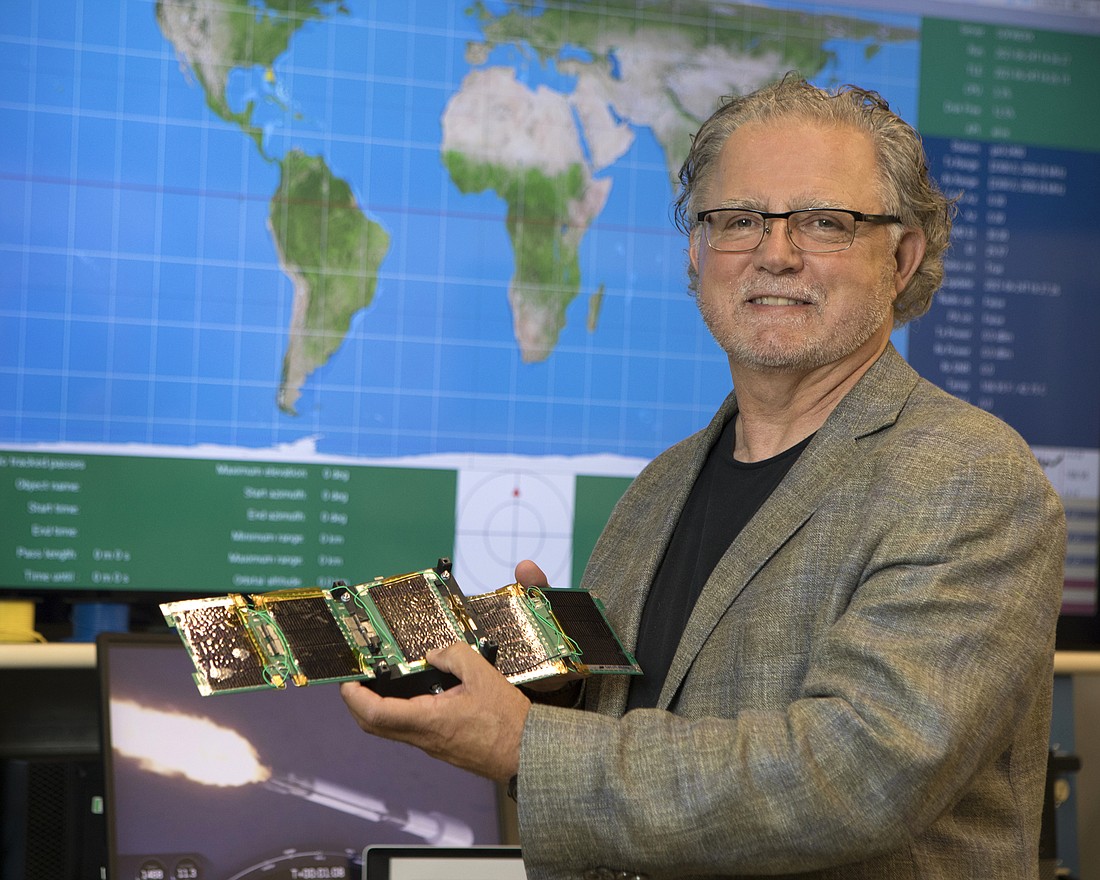- January 14, 2025
-
-
Loading

Loading

When you think of a satellite, what comes to mind? Some sort of spaceship with panels beaming information back and forth from Earth? Or, maybe, a dish on a neighbor’s roof or behind a house off some country road?
You’d be right in both cases. But the satellite sitting on a worktable at the Institute of Applied Engineering in Tampa is different.
It’s a little black box, about the size of a box of playing cards if the playing cards were square. It opens, revealing panels covered in panels that the military uses to…well that’s about all that can be said about this satellite for now.
Actually, one more thing can be said about it: It was designed at the institute by a group of engineers as part of a military contract. It will be tested in a real-world environment —outer space — and one day, possibly, manufactured by contractors at the request of the Pentagon.
'I believe engineering should be everywhere. Engineering should be on display. Engineering should be out with the community, not behind castle walls.” Robert Bishop, Institute of Applied Engineering, Tampa
Tucked in a corner of the University Mall on Fowler Avenue in Tampa, next to what once was a Dillard’s, the institute, a nonprofit that is part of the University of South Florida’s school of engineering, works on government research contracts. It's focus: find engineering solutions for the Department of Defense, federal and state agencies, as well as various industries. A working lab, the institute also gives undergraduate students workforce skills and helps others work on advanced degrees.
The space it occupies is part of a redevelopment of the mall aimed at creating a hub of innovation-focused tenants, mostly in research, technology and medicine. The project is called Rithm At Uptown — it stands for research, innovation, technology, humanity and medicine.
As the rare shopper straggles by, engineers, scientists and technicians inside the institute’s facility work away on hardware-and-software-based applied research, as well developing advanced technological tools.
Robert Bishop, dean of the USF engineering school and president and CEO of the institute, began thinking about the Institute as far back as 2015.
Raised on military bases in Europe, he earned his undergraduate and master’s degrees from Texas A&M and is Ph.D. from Rice University. After a few years in the private sector, he joined the faculty at The University of Texas in Austin and later moved to Marquette University in Milwaukee. He came to USF as dean of the engineering school about seven years ago.
Bishop considered the institute an avenue to catapult the school of engineering into one of the top programs in the country. For that to happen, though, USF needed to work with specialists and organizations in order to improve its research and create the academic backbone.
The key to that was building a relationship with the Department of Defense, particularly MacDill Air Force Base, a 20-mile drive from campus.
He began to develop the relationships and in February 2020 the U.S. Special Operations Command, based at MacDill, awarded the Institute a five-year contract that could, eventually, be worth up to $85 million. The contract, according to the Institute, calls for it to use its expertise in “applied research and advanced technology developments…to support USSOCOM’s needs in a range of scientific and engineering disciplines.”
SOCOM “develops and employs fully capable Special Operations Forces to conduct global special operations,” according to its website. Its duties are the stuff of Tom Clancy novels, counterterrorism, humanitarian assistance, special reconnaissance and countering weapons of mass destruction.
For Bishop, the institute and the work it does with the military, and others, is about doing what engineers do best: solving problems.
Bishop believes that engineers working with others, from any field, can develop solutions for a host of issues — from finding ways to deal with the long term effects of repetitive, sub-concussive blasts on soldiers, to designing and operating small satellites that push the frontiers of thin communications into orbit, to helping policymakers make decisions that will lead to wars that are less lethal.
“I believe engineering should be everywhere,” Bishop says. “Engineering should be on display. Engineering should be out with the community, not behind castle walls.”
The institute, though, is not actually working to develop products. What it does is research and find solutions, building prototypes passed onto the agency that hired it. Said agency then evaluates the product and makes a determination whether to move forward with contractors.
One of the Institute’s main, though unheralded, functions is giving engineering students real life experience, preparing them to go out into the workforce locally and statewide. Bishop says the Institute’s ability to get these students hands-on training, while not flashy, is crucial.
“In my opinion, that’s a part of our mission. That maybe doesn’t sound as exciting as putting satellites up in space,” Bishop says, “but we put satellites up in space with 23 students, undergrads. Undergraduates helped build and design three satellites.”
The students work with Ph.D. candidates and established engineers on a wide range of projects at the institute. Rather than working on theoretical projects and assignments in a classroom, students work on contracts for clients. That means they have to learn to handle oversight and be accountable while meeting the rigorous standards demanded by a paying client. And in most cases, that client is the U.S. Department of Defense.
“To me, that’s the story. That industry is benefitting from the work we’re doing here,” Bishop says. “We are an educational institution, our main mission is students. But it’s very rare that you have an organization that giving students the opportunity to do things with a customer.”